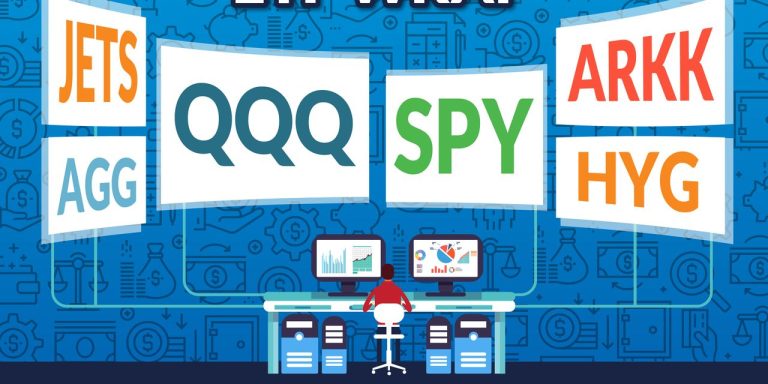Hello! This is MarketWatch reporter Isabel Wang bringing you this week’s ETF Wrap. In this week’s edition, we look at the increasingly popular “buffer” ETF concept. Innovator Capital Management launched an ETF that may offer investors complete protection against stock-market losses over a two-year timeframe.
Please send tips, or feedback, to [email protected] or to [email protected]. You can also follow me on Twitter at @Isabelxwang and find Christine at @CIdzelis.
Sign up here for our weekly ETF Wrap.
The pioneer and provider of the world’s largest lineup of buffer exchange-traded funds (ETFs), or defined outcome ETFs, has launched a new product that could provide investors 100% protection against stock-market losses as well as potential gains with a cap over a two-year timeframe.
The Innovator Equity Defined Protection ETF
TJUL,
the “first-of-its-kind” fund aims to offer investors the upside return of the SPDR S&P 500 ETF Trust
SPY,
to a 16.62% cap, and a complete buffer against its downside over a two-year outcome period, according to a company statement on Tuesday.
“We saw that clients hold on too much cash and the reason for that is they’re fearful of getting into the market or they can’t stomach the short-term drawdown and the short-term volatility that comes along with equity investing,” said Tim Urbanowicz, head of research and investment strategy at Innovator ETFs. “What we wanted to do is really provide a way for investors to get cash off the sidelines, get into the market, and know that you have 100% downside protection.”
Strategists at Innovator ETFs are seeing a surging amount of cash move into market-linked CDs, cash, bank deposits and fixed-indexed Treasuries when investors are facing uncertain market conditions amid sticky inflation and interest-rate hikes by the Federal Reserve. That means there is a high demand for buffer ETFs like TJUL, which have a “return potential significantly higher with this strategy than any of other options,” Urbanowicz told MarketWatch in a phone interview on Thursday.
Meanwhile, unlike fixed-indexed annuities and market-linked CDs, TJUL is expected to provide investors a beneficial 1099 tax treatment. It does not carry bank credit risk as the fund is not backed by the faith and credit of an issuing institution, and it does not require a minimum investment.
“We see a pretty big tax advantage for the strategy relative to cash, cash like instruments and T-bills, where those strategies are paying out interest that’s going to be taxed at ordinary income rates,” said Urbanowicz. “With this strategy, there’s no distributions that are taking place, so it really allows clients more control as to when they pay taxes, as long as they hold the ETF for a year, that gain is going to be taxed at a long-term capital gain rate.”
See: This ‘buffer’ strategy for stock market investors has been a winner
Buffer ETFs emerged years ago as standout options for investors looking to manage market volatility. However, they have become particularly prominent this year, and further growth has appeared after BlackRock, the world’s largest asset manager, recently debuted its first two buffer funds, the iShares Large Cap Moderate Buffer ETF
IVVM,
and iShares Large Cap Deep Buffer ETF
IVVB,
See: BlackRock launches its first ‘buffer’ ETFs for stock-market investors worried about a potential fall
Charles Champagne, head of ETF strategy at Allianz Investment Management, said fund managers of buffer ETFs usually utilize an options-based strategy. “How we do it is we buy a call deep in the money so that gives us a long equity exposure. And then we overlay a put-spread on top of that, which creates that downside buffer, and then we sell a call, which then defines that upside cap.”
Investors will consider buying call options if they are optimistic about the prospects of its underlying shares. In other words, if the market goes up, they will buy the shares in the future at today’s prices. When selling a call option, they’re selling the right to purchase underlying shares at a set price before a certain date. If the price stays the same or goes down, investors will keep the premium as profit. The bull put spread, as shown in the chart below, is used when the option trader thinks that the underlying security’s price will rise before the put options expire.
SOURCE: INNOVATOR ETFS
As a relatively newer asset manager to the buffer ETF space, strategists at Allianz Investment Management (AllianzIM) saw great growth in its defined outcome ETF business last year when both the stock and fixed-income markets crashed.
They started 2022 with over $342 million in assets under management and ended the year at around $800 million. However, investors started flocking into buffer ETFs in 2023 due to a lack of conviction in the markets, bringing the firm’s suite to roughly $1.3 billion as of July 14, according to AllianzIM data shared with MarketWatch.
For example, the AllianzIM U.S. Large Cap Buffer 20 January ETF
JANW,
which is designed to provide a downside buffer of 20% against market drops over a 12-month period, has risen 10% so far this year, compared to an 18.2% gain in the SPDR S&P 500 ETF Trust, according to FactSet data.
However, this popular type of ETF might not be a good fit for investors that have “high risk tolerance” or do not factor in negative outcomes from their equity positions, warned Champagne.
“[These products are not designed for] investors that are seeking alpha generation for their portfolio or are really bullish on it with a short-term view on the markets. They’re more designed for investors that do want to play in the equity markets but don’t want to take all of the risks involved with that,” he told MarketWatch via phone on Thursday.
Meanwhile, some risk-averse investors would rather hold Treasury bills, which are still one of the safest places to store their savings and earn interest in the short-term, as the 3-month Treasury bill rate
TMUBMUSD03M,
stood at 5.40%, while the 2-year Treasury
TMUBMUSD02Y,
yielded 4.85% after reaching a level not seen in 16 years earlier this year, according to FactSet data.
The good…
| Top Performers | %Performance |
|
SPDR S&P Regional Banking ETF KRE, |
7.3 |
|
iShares U.S. Healthcare Providers ETF IHF, |
6.2 |
|
SPDR S&P Bank ETF KBE, |
6.1 |
|
iShares U.S. Regional Banks ETF IAT, |
5.9 |
|
Invesco KBW Bank ETF KBWB, |
4.5 |
| Source: FactSet data through Wednesday, July 19. Excludes ETNs and leveraged products. Includes NYSE, Nasdaq and Cboe traded ETFs of $500 million or greater. | |
…and the bad
| Bottom Performers | %Performance |
|
KraneShares CSI China Internet ETF KWEB, |
-6.2 |
|
ProShares Bitcoin Strategy ETF BITO, |
-5.9 |
|
Invesco China Technology ETF CQQQ, |
-4.7 |
|
WisdomTree China ex-State-Owned Enterprise Fund CXSE, |
-4.1 |
|
iShares MSCI China ETF MCHI, |
-3.9 |
| Source: FactSet data | |
New ETFs
-
Avantis Investors Thursday launched a new exchange-traded fund Avantis International Small Cap Equity ETF
AVSC,
-0.06%
which invests in a diverse group of non-U.S. small-cap companies across market sectors, industry groups and countries. -
Touchstone Investments Tuesday announced the launch of the Touchstone Securitized Income ETF
TSEC,
+0.06% ,
an actively-managed, fully-transparent ETF that seeks to invest in a diversified portfolio of fixed-income securities, which began trading on July 19, 2023.
Weekly ETF reads
Read the full article here









